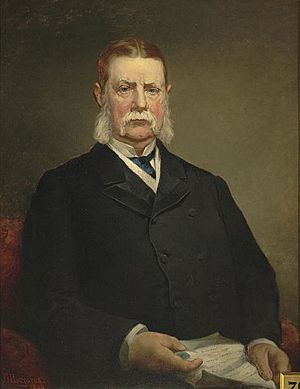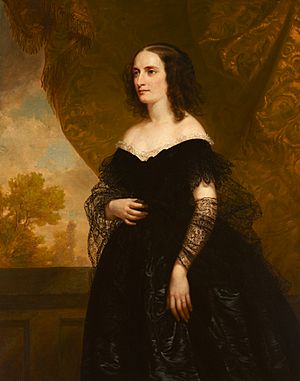John Jacob Astor III facts for kids
Quick facts for kids
John Jacob Astor III
|
|
|---|---|
 |
|
| Born | June 10, 1822 |
| Died | February 22, 1890 (aged 67) New York City, New York, U.S.
|
| Resting place | Trinity Church Cemetery, New York City, New York, U.S. |
| Alma mater | Columbia University University of Göttingen Harvard Law School |
| Occupation | Financier, philanthropist |
| Spouse(s) | Charlotte Augusta Gibbes (m. 1846–1887; her death) |
| Children | William Waldorf Astor |
| Parent(s) | William Backhouse Astor Sr. Margaret Alida Rebecca Armstrong |
| Relatives | See Astor family |
| Signature | |
John Jacob Astor III (born June 10, 1822 – died February 22, 1890) was an important American businessman and a generous giver to charities. He also served as a soldier during the American Civil War. He was a very rich member of the Astor family. John Jacob Astor III became the wealthiest person in his family during his time. He also started the English part of the Astor family.
Contents
Early Life and Education
John Jacob Astor III was the oldest son of William Backhouse Astor Sr.. His father was a successful real estate businessman. His mother was Margaret Alida Rebecca Armstrong. His younger brother, William Backhouse Astor Jr., continued the main American Astor family line.
His grandparents on his father's side were John Jacob Astor, who was a fur trader, and Sarah Cox Todd. His grandparents on his mother's side were Senator John Armstrong Jr. and Alida Livingston. The Livingstons were another well-known family.
John Astor III went to Columbia College and finished in 1839. He also studied at the University of Göttingen in Germany. Later, he attended Harvard Law School and graduated in 1842. He worked as a lawyer for one year. This helped him learn how to manage his family's huge wealth. He later inherited half of this wealth. The family's fortune began with his grandfather, who controlled the fur trade in the early 1800s.
Business Ventures
John Astor III tried investing in railroads. However, he was outsmarted by a famous businessman named Commodore Cornelius Vanderbilt. Astor had to give up control of the original New York Central Railroad line to Vanderbilt. This line ran from Albany to Buffalo.
His main business was managing the huge Astor family land and buildings in New York City. He managed these properties very well. He made a lot of money from them and was careful with his spending.
Military Service During the Civil War
Before the war, Astor was chosen as a lieutenant colonel in the 12th Regiment of the New York Militia. He left this position in 1853.
During the American Civil War, John Astor III volunteered to help. He served as an aide-de-camp (an assistant) to Major General George B. McClellan. At the time, McClellan was the commanding general of the U.S. Army. Astor served from November 1861 to July 1862.
He was recognized for his help during the Peninsular Campaign. In March 1865, he was given the honorary rank of brigadier general of Volunteers. This is called being "brevetted."
In 1880, he joined the New York branch of the Military Order of the Loyal Legion of the United States. This was a group for officers who had served in the Union army. He loved his time serving in the Civil War. He eagerly attended meetings of the Loyal Legion.
Generous Giving and Support
John Astor III was a very generous person. He gave many items and money to the Metropolitan Museum of Art. In 1887, he gave the museum his wife's valuable collection of laces. He also left $50,000 to the museum in his will.
He and his brother gave a special memorial to their father at Trinity Church. This included a carved reredos (a screen behind an altar) and an altar. It cost $80,000.
He left $450,000 to the Astor Library in his will. This brought the total amount his family had given to the library to about $1,500,000. He also gave a lot of money to other hospitals and charities. These included the New York Cancer Hospital ($100,000), the Woman's Hospital, St. Luke's Hospital ($100,000), and the Children's Aid Society.
Astor was very involved with the Astor Library, not just with money. He was the treasurer of its board of trustees. In 1879, he gave the library the land for a new part of the building. He also gave his own collection of old books and rare handwritten documents to the library.
His wife, Charlotte, was also very religious and charitable. She supported the new Children's Aid Society. She was on the board of the Women's Hospital of New York. This hospital did not accept cancer patients, which upset her. She convinced her husband to donate $225,000 to build the first wing of the New York Cancer Hospital. This wing was called the "Astor Pavilion." For twenty years, she also supported a German industrial school. From 1872 until she died, she helped manage the Woman's Hospital. She also helped Native Americans through the Niobrara League and many other charities. She left $150,000 to charity in her will.
Personal Life and Family
On December 9, 1846, John Astor III married Charlotte Augusta Gibbes. Their wedding was at Trinity Church in New York City. Charlotte was born on February 27, 1825, and died on December 12, 1887. Her parents were Thomas Stanyarne Gibbes Jr. and Susan Annette Vanden Heuvel.
John and Charlotte had one child together. Their son, William Waldorf Astor, was born in 1848. William Waldorf Astor later became the 1st Viscount Astor. He married Mary Dahlgren Paul.
In 1859, John Jacob Astor III built a home at 338 Fifth Avenue in New York City. Today, the famous Empire State Building stands at that address. Later, he built a grand vacation home called Beaulieu in Newport, Rhode Island. He also had a country estate called Nuits in Irvington, New York.
In his later years, Astor visited London more often. His son, William Waldorf Astor, moved to London permanently with his family in 1891. He became a British citizen in 1899 and was later given the title Lord Astor.
John Jacob Astor III passed away on February 22, 1890. He was buried in the Trinity Church Cemetery in Manhattan.



